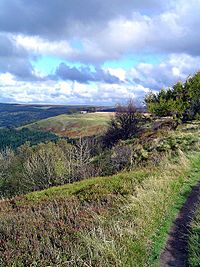Ryedale Windypits facts for kids
| Site of Special Scientific Interest | |

Image taken from Hillfort windypit
|
|
| Area of Search | North Yorkshire |
|---|---|
| Coordinates | 54°14′20″N 1°06′11″W / 54.238909°N 1.103146°W |
| Interest | Geological and biological |
| Area | 27.74 acres (0.1123 km2; 0.04334 sq mi) |
| Notification | 1960 |
The Ryedale Windypits are cool natural underground places. They are found inside the North York Moors National Park. These are cracks in the ground, called fissures, located in the Hambleton Hills. They are near Helmsley, on the western slope above the River Rye. These spots are very important for understanding history and nature.
What Are Windypits?
The name "Windypits" comes from how they act. They often blow out gusts of air and even steam from their narrow openings. This happens because the air inside the cracks is a different temperature than the air outside.
In winter, you might see steamy mist rising from the holes. It can look like small puffs or jets. In warmer months, you can feel cold air blowing from the entrances. Sometimes, this air moves so strongly it can make nearby leaves shake!
There are over 40 known windypits in the area. However, only four of them have important historical finds. These four are called Antofts, Ashberry, Bucklands, and Slip Gill. Because they are so important for geology (the study of Earth's rocks), some windypits are protected areas. They are known as SSSIs.
Who Uses the Windypits?
The windypits are popular spots for people who explore caves, known as cavers and potholers. They are also super important for bats! Many bats gather and sleep here. Seven different types of bats have been seen, including whiskered bats, Daubenton's bats, Natterer's bats, and brown long-eared bats. All the Ryedale Windypits are found in or near woodlands or forest areas.
Exploring the Windypits
The first time someone officially explored a Windypit was in 1832. This was done by a person named Rev. William Buckland. Later, in the middle of the 1900s, more caves were explored and dug into.
Historians believe that some human remains found in four of the Windypits are from a very long time ago. They are thought to be from the Late Neolithic period or Early Bronze Age. This is because of other items found with them, like Beaker pottery and flint tools.
Windypits and History
In 2011, a TV show called History Cold Case featured the Ryedale Windypits. A team from the University of Dundee looked at some bones found in Slip Gill Windy Pit in the 1950s. These bones were about 2,000 years old.
The team used forensic science to study the bones. They found signs that some of the people had been hurt. When they looked at bones from other nearby pits, they saw similar signs. This showed that there might have been fighting or violence among people long ago.

